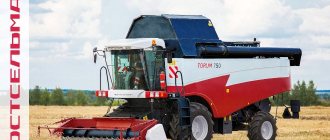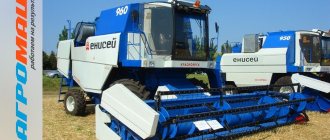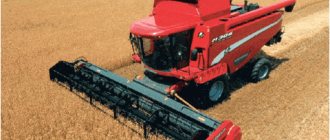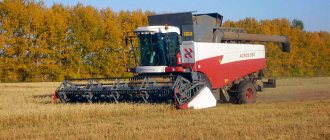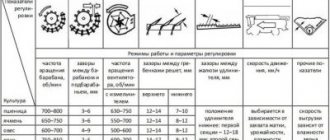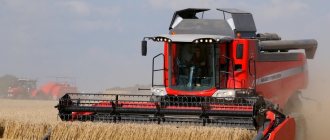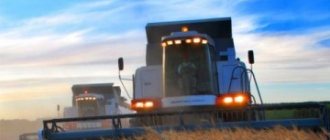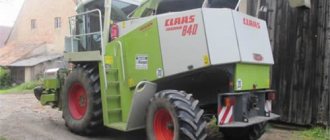One of the largest manufacturers of combine harvesters in the world and the largest in Russia is the Rostselmash company. Consumers are offered a wide range of models, which includes a variety of machines from the largest, most productive and technologically advanced, to small, cheap to maintain and most economical.
Rostselmash combines
The Rostselmash company was founded in 1929 and at the beginning of its journey was a plant for the production of agricultural implements. Currently, it is Russia's leading manufacturer of agricultural equipment, which is also considered one of the largest in the world and is part of a group of 13 companies producing equipment around the world.
One of the most important areas is the production of grain and forage harvesters, of which more than 2.6 million units were assembled, which is the largest figure in the world.
Peculiarities
The machines of the Rostov Combine Harvester Plant use the latest technologies for stable and efficient operation, including various computer systems: hydrostatic transmission, which extends the service life of the machine, makes the operator’s work easier and increases the accuracy of speed control; modern threshers and grain separation systems that provide maximum grain cleaning without damaging the crop; hydraulic steering system, which also makes steering easier and also ensures reliability and precision.
Combine harvesters from Rostselmash use a longitudinal-transverse copying system, which will allow you to effectively use the entire length of the header even on fields with uneven surfaces.
The cabs are equipped for maximum visibility and driver comfort in order to create optimal working conditions in hot or cold weather, reduce workload, and prevent boredom during long-term work.
Advantages and disadvantages
Advantages:
- Good harvesting accuracy;
- Reliable and modern equipment that, if properly used, will last a very long time;
- Optimal price/quality ratio;
- A large selection of combine harvesters, which will allow you to choose the optimal power and equipment for any field;
- A large number of dealers will allow you to carry out timely maintenance and purchase any spare parts.
Despite the remarkable characteristics, the equipment from Rostselmash does not reach the indicators of the main leaders in the care, completeness of harvesting, as well as the power and capacity of combines.
Versatile tractors
With the purchase of a tractor plant in Canada, Rostselmash acquired a whole line of ready-made tractor models, which all that remained was to give them a more modern look and establish sales. The main focus of the Canadian plant was the production of powerful tractors from 300 hp, and the Rostovites did not radically change the production line. Currently, three series of tractors are produced.
— Series 2000 — tractors with a power of 335 - 375 hp. on wheels
— 4WD series — tractors 395 — 620 hp. on wheels
— DT Series — tractors with a power of 395 - 575 hp. on caterpillar tracks
In the future, a slight reformatting of the model range and a slight expansion of the line are planned. Partial production will be moved to Rostov. However, there are more than enough competitors on the market. In Russia these are Kirovians and Belarusians. Abroad, these are the same Case IH, John Deere, Caterpillar, NewHolland, Claas, JCB. Yes, in general, almost every major tractor manufacturer is trying to offer the buyer tractors with a power of 300+ hp, so the struggle for your buyer will be difficult, but nothing is impossible.
Forage harvesters
Combines can be equipped with various adapters, such as rotary corn headers for harvesting grass, as well as a pick-up for making hay from pre-cut and windrowed grass. Such machines are used for cutting and maximum grinding of forage crops. Unlike grain harvesting machines, they do not have their own bunker.
RSM 1401
The main requirement for RSM machines is high productivity, versatility and minimal material costs for maintenance. The technological path can be designed for easy and fast passage of the crushed product and can be equipped with a re-grinder. The standard equipment includes metal and stone detectors that prevent debris from getting into the crushed food. The grinding apparatus uses a direct drive.
Optionally, you can add a system for adding preservatives, video surveillance, an air compressor for cleaning the mechanism after work, as well as an automated lubrication system.
Rostselmash recently introduced a new model RSM 161, which is built on a fundamentally new platform using only the developments of Russian engineers. The machine's productivity was 23 tons per hour, and losses do not exceed 0.7%, thanks to which the combine can compete with the best world analogues.
Technical characteristics of the forage harvester RSM 2401:
| Characteristics | Indicators |
| Engine | MTU OM-460 LA |
| Power, hp | 456 or 510 |
| Fuel tank, l | 1080 (two 540) |
| Width of the feeding apparatus, mm | 680 |
| Diameter/length of the grinding apparatus, mm | 630/700 |
| Unloading height, m | 6,3 |
| Productivity, t/h | 140 |
| Transport/working speed, km/h | 30/15 |
| Dimensions LxWxH, mm | 6170/3250/3800 |
| weight, kg | 9900 |
| Harvester for coarse crops, m | 4,5 |
| For harvesting herbs, m | 5 |
| Pick-up, m | 3 |
Video review of the new combine from Rostselmash RSM 161:
DON 680M
These machines are best suited for small farms that require a machine for daily feeding. The car is similar to the larger RSM model, with the exception of simpler controls without a rear view camera monitor, and the information panel has been simplified somewhat. Optionally includes only a system for adding preservatives.
Technical characteristics of the DON 680M combine:
| Characteristics | Indicators |
| Power, hp | 290 |
| Fuel tank, operating hours | 11 |
| Cutting length, mm | 3,5-20 |
| Header width, m | 3-5 |
| Unloading accelerator rotation speed, m/s | 48,5 |
| Unloading height, m | 4,7 |
| Productivity, t/h | 108 |
| Transport/working speed, km/h | 20/10 |
The video shows the DON 680M forage harvester:
Sterh 2000
This is a trailed combine harvester that can be mounted with a variety of tractors. Its main advantage is its versatility, as it can mow, chop and re-grind various forage crops, as well as lay them in a row or load them into a vehicle. There are also two loading options: you can attach the drive to the back of the combine or put the chopped feed into a nearby vehicle. The knives rotate due to power take-off from the tractor.
Technical characteristics of the Sterkh 2000 combine:
| Characteristics | Indicators |
| Productivity, t/hour | 38 |
| Rotation speed of the grinding apparatus, rpm | 1000 |
| Working width, m | 2 |
| Guarantee | 2 years |
Photo of the Sterh 2000 combine
Grain harvesters
Combine harvesters differ from the equipment described above. Their task is not only to cut and chop the stems, but also to separate the grain, and then store it in a bunker until unloading. As a result, the main criteria are the percentage of yield loss, as well as the purity of separation and the integrity of the grains.
Torum 780/750
One of the largest and most productive grain combines in the world, which can harvest over 2000 hectares per season or 300 hectares in one shift. At the heart of the machine is the unique ARS threshing system, which includes an innovative beater feeder, rotating deck and continuously variable rotor drive.
Thanks to the design of the chamber, the throughput of the mechanism increases, and energy costs are reduced by 15%. A unique two-stage cleaning system has also been used, which reduces the amount of husk in the final product. You can also note the terrain copying system, which will allow you to work efficiently even with the longest headers.
Thanks to the technologies used, the combine harvester is not only one of the most productive, but also provides the best results in grain cleaning. And due to its versatility, the machine can be equipped with headers for rice, sunflower, corn, rapeseed, small-seeded crops, as well as pickers.
Technical characteristics of Torum combines:
| Model | TORUM 780 | TORUM 750 |
| Header working width, m | 6/7/9 | 6/7/9 |
| Rotor drum diameter/length, mm | 726/3200 | 726/3200 |
| Concave area, sq.m. | 5,4 | 5,4 |
| Hopper capacity, l | 12000 | 10500 |
| Unloading speed, l/s | 105 | 105 |
| Unloading height, m | 5,4 | 5,2 |
| Rotation speed of the chopping drum, rpm | 1600/3400 | 1600/3400 |
| Engine power, l. With. | 506 | 425 |
| Tank capacity, l | 850 | 850 |
| Dimensions LxWxH, m | 8931/3677/3950 | 8931/3677/3950 |
| Weight, kg | 16350 | 16350 |
Photo of the Torum 780/750 combine
Acros 595 plus
It is also a fairly large machine, but its key features are its versatility, gentle handling of grain and straw, and ease of setup and maintenance. Of course, the model is much more modest than the previous TORUM, since Acros is capable of harvesting only 1000 hectares per season, ranging from grain crops to corn.
Among the interesting features of the machine is an improved unloading device, which can provide a speed of 90 l/sec. It is also worth specifying a system for automatically copying the relief, which will allow you to work on fields with any relief.
Technical characteristics of the Akros grain combine from Rostselmash:
| Characteristics | Indicators |
| Header working width, m | 5/6/7/9 |
| Rotor drum diameter/length, mm | 800/1480 |
| Concave area, sq.m. | 1,38 |
| Hopper capacity, l | 9000 |
| Unloading speed, l/s | 90 |
| Unloading height, m | 4,3/4,7 |
| Rotation speed of the chopping drum, rpm | 1800/3400 |
| Engine power, hp | 325 |
| Tank capacity, l | 540 |
| Dimensions LxWxH, m | 8850/3880/3940 |
| Weight, kg | 14330 |
Photo of grain combine Acros 595 plus
Acros 585/550
There are no special differences in the technologies used between these models and the one presented above. The only thing we can highlight is the lack of a relief copying system. Otherwise, the machines differ in power and performance, but they can still remove more than 1000 hectares per season.
Specifications:
| Model ACROS | 585 | 550 |
| Header working width, m | 5/6/7/9 | 5/6/7/9 |
| Rotor drum diameter/length, mm | 800/1480 | 800/1480 |
| Concave area, sq.m. | 1,38 | 1,38 |
| Hopper capacity, l | 9000 | 9000 |
| Unloading speed, m | 90 | 90 |
| Unloading height, m | 4,3/4,7 | 4,3/4,7 |
| Rotation speed of the chopping drum, rpm | 1800/3400 | 1800/3400 |
| Engine power, hp | 300 | 280 |
| Tank capacity, l | 540 | 540 |
| Dimensions LxWxH, m | 8600/3880/3940 | 8600/3880/3940 |
| Weight, kg | 13380 | 13380 |
Photo of combine harvester Akros 585/580
Vector 450 track
This combine was developed specifically for difficult soil conditions. Thanks to its tracked chassis and large supporting surface, it is the only one capable of working in muddy fields.
There is no relief copying system, as well as any innovative technologies. Perhaps this is just a small and reliable combine that can satisfy all the needs of small and medium-sized fields.
Technical characteristics of the vector 450 track combine harvester:
| Characteristics | Indicators |
| header working width, m | 5/6/7/9 |
| Rotor drum diameter/length, mm | 800/1180 |
| Concave area, sq.m. | 1,1 |
| Hopper capacity, l | 6000 |
| Unloading speed, l/s | 50 |
| Unloading height, m | 5,0 |
| Rotation speed of the chopping drum, rpm | 2900 |
| Engine power, hp | 255 |
| Tank capacity, l | 540 |
| Dimensions LxWxH, m | 7940/3900/4000 |
| Weight, kg | 16810 |
Vector 420/410
These combines are the best solution for small fields and are capable of harvesting an average of 750 hectares per season. The company's engineers were able to achieve the optimal balance between the quality of processing, the percentage of grain retained, as well as the cost of maintenance and operation. The build quality, as well as the level of cabin comfort, remain at the same level as the most expensive models.
Technical characteristics of VECTOR 410/420:
| Characteristics | Indicators |
| header working width, m | 5/6/7/9 |
| Rotor drum diameter/length, mm | 800/1180 |
| concave area, sq.m. | 1,1 |
| Hopper capacity, l | 6000 |
| Unloading speed, l/s | 50 |
| Unloading height, m | 3,48 |
| Rotation speed of the chopping drum, rpm | 2900 |
| Engine power, hp | 210 |
| Tank capacity, l | 540 |
| Dimensions LxWxH, m | 7938/3559/4010 |
| Weight, kg | 11075 |
Video review of the Vector 410/420 grain combine:
Niva
This is the smallest and cheapest combine harvester that uses a classic thresher. Its layout is currently the most common in the world. The model does not stand out for its special quality of processing or level of comfort, however, due to the low cost of purchase and operation, as well as ease of operation and maintenance, it becomes an ideal solution for small farms.
Also, due to its small size and light weight, the machine is well suited for working in small fields with complex contours.
Specifications:
| Characteristics | Indicators |
| Header working width, m | 4,1/5 |
| Rotor drum diameter/length, mm | 600/1180 |
| Concave area, sq.m. | 0,93 |
| Hopper capacity, l | 3000 |
| Unloading speed, l/s | 40 |
| Unloading height, m | 4,34 |
| chopping drum rotation speed, rpm | 2900 |
| Engine power, hp | 155 |
| Tank capacity, l | 300 |
| Dimensions LxWxH, m | 7607/3930/4100 |
| Weight, kg | 7400 |
Threshing and separating device
The classic single-drum thresher with a threshing drum with a diameter of 600 mm provides exceptionally gentle threshing (including thin-layer threshing). At the same time, the thresher has a fairly simple design.
The progressive design of the 2-section deck, together with significant coverage, provides a concave area of 0.93 sq.m, unimaginable for other combines of this class, which directly affects the high productivity of the machine.
Type of threshing apparatus: drum with receiving accelerating beater. A reduction gearbox is an additional option. The sub-drum space is adjusted by an electric drive directly from the operator’s cab.
To clean the heap, a two-sieve cleaning system is used. The significant drop height and the finger grid on the preparation board greatly optimize the cleaning process. The total area of the sieves is 3.59 square meters, and this is one of the best indicators in this class of combines.
The cleaning system uses a six-bladed fan, the rotation speed of which can be easily adjusted directly from the cab and displayed on the control panel.
The principle of final grinding is the following: return to the drum. When working on slopes, in order to reduce losses, it is optionally possible to install high dividers on the upper sieve. Practice shows that losses are reduced by more than 1 percent, and the greater the deviation from the horizon, the greater the effect.
